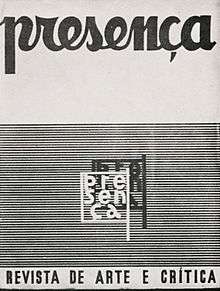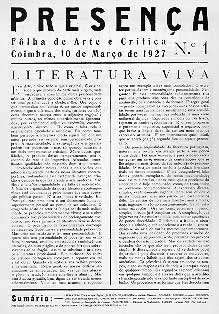Presença
 Cover of an issue of Presença | |
| Year founded | 1927 |
|---|---|
| Final issue | 1940 |
| Country | Portugal |
| Language | Portuguese |
Presença - Folha de Arte e Crítica (Portuguese for "Presence") was a Portuguese review published in Coimbra from 10 March 1927 until 1940 and published 54 volumes.
History
With different experiences in a short time, with Tríptico which was the important moment in history, João Gaspar Somões and Branquinho da Fonseca founded in 1927 for the series that was famous with the Conimbrigian leaves , it was mainly headed by José Régio. Branquinho da Fonseca no longer headed the review after the 27th volume in 1930, for considering an imposition on creative freedom, an answer generally understood as an reaction on the rise of Régio. A part of the 33rd volume made on November 1938, the review passed against with the presence on its tripartite heading by Adolfo Casais Monteiro. A year later, the revista was reformulated, started a new series with a large format and with more pages. The review serecary was Alberto de Serpa and published about two volumes, November 1939 and February 1940. Presença review started to be dissolved due to ideological struggles between Gaspar Simões and Casais Monteiro.
Although secondarily, it had controlled the arts, Presença published texts under the area of Diogo de Macedo, José Régio, and battled the review served the support of the First Independent Salon in 1930. Writers that worked with the review including the men from First Modernism, Adolfo Correia Rocha, later on, he used some pseudonums including Miguel Torga, Aquilino Ribeiro, Edmundo de Bettencourt, Carlos Queiroz, Júlio/Saul Diar and all the generations of poets, prosers, pensioners and plastic artists, which simply called "the presence generation" or its presenters. Numerous writers that published the magazine included Almada Negreiros, Júlio Diogo de Macedo, Dordio Gomes, Sarah Afonso, Arlindo Vicente, Bernardo Marques, Mário Eloy, João Carlos, Paulo Ferreira, Ventura Porfírio, Arpaz Szenes, Maria Helena Vieira da Silva (in 1940), etc.[1]

Editorial line
Presença defended the creation of a more lively literature, opposed to academism and routine journalism, firstly among the crisits, which predominated the individual about the collective, the psychology on social, the intuitoin on the removal. Choosing the "masters", the artists from the Orpheu review, many of which took part in Presença, the review the most important that circulateda a second part of Modernism, usually designated for Second Modernism, the most critic that theorized the creative. Noteworthy its critical spirit not only from the founders but from Albano Nogueira and Guilherme de Castilho, were good doctrine contributors along with José Bacelar, José Marinho, Delfim Santos, Saul Dias, Fausto José, Francisco Bugalho, Alberto de Serpa, Luís de Montalvor Mário Saa, Raul Leal and Antonio Botto.
The review divided into its pages by different authors associated with the First Modernism, having its tutelary figures by other writers including Fernando Pessoa, Mário de Sá-Carneiro, Almada Negreiros and Afonso Duarte, also with the contributions by António de Sousa, Irena Lisboa (with some poems in a prose), Vitorino Nemésio, Pedro Honem de Mello Tomás de Figueiredo and Olavo de Eça Leal. All these were given on the poetry (marked by a certain "provençal lyriciam"), brought António de Navarro who had headed the longest of the poetic heritage of Orpheu of that review.
The poetry which featured "presentists" which was based on the text of the compositions of Song of Coimbra and fado sung by Amália Rodrigues.
The review had headed to be the main works of European writers of the early 20th century including Marcel Proust, André Gide, Paul Valéry, Guillaume Apollinaire and Pirandello.
Its pages served among the promotion and literary exchange between different Brazilian poets and prosers, the line of its official initiatives.
References
- ↑ França,José Augusto – A Arte em Portugal no Século XX': 1911-1961 (Art in Portugal in the 20th Century: 1911-1961 [1974]. Lisbon: Bertrand, 1991, p. 551